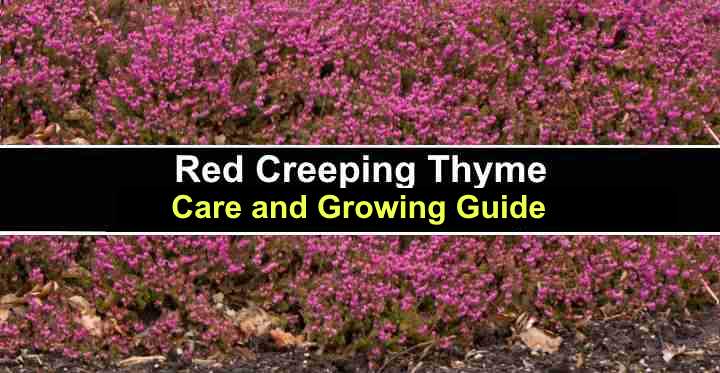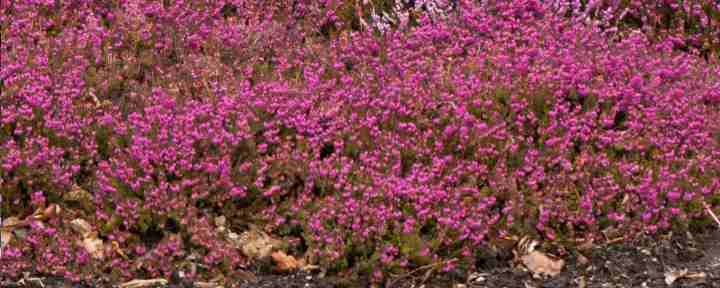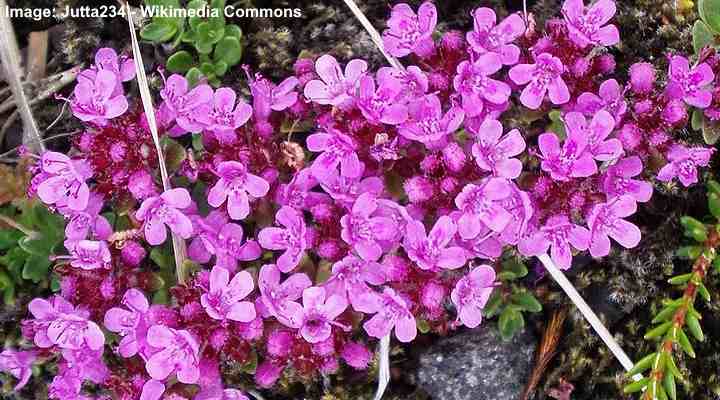Red Creeping Thyme (With Pictures) – Identification and Growing Guide

Red creeping thyme is a colorful, herbaceous ground cover shrub with spectacular deep pink-red tubular flowers. Creeping thyme, with its semi-evergreen foliage, is an excellent mat-forming landscaping shrub. And when red creeping thyme blooms in summer, it transforms gardens with a carpet of dark pink, magenta, and deep reddish hues.
The beauty of red creeping thyme is that it is low maintenance and requires little effort to grow. The horizontally spreading stems root in the soil and are covered with densely growing dark green leaves and dark pink-reddish flowers. In addition to its visual appeal, the small dark-green leaves are exceedingly fragrant and give off a herby aroma.
Red creeping thyme has several uses in a garden landscape. In addition to being ideal for full-sun ground cover, you can plant it as a border plant or edging to add color and texture to foundation plantings or as a lawn alternative. Its trailing flowering aromatic stems also work well in containers or hanging baskets.
This article is an identification and growing guide for the popular red creeping thyme shrub. As well as pictures and descriptions of the red-flowering ground cover plant, you will get handy tips on propagating, planting, and growing red creeping thyme in your garden landscape.
What is Red Creeping Thyme (Thymus praecox ‘Coccineus’)?

Red creeping thyme (Thymus praecox ‘Coccineus’)
Red creeping thyme is a perennial herbaceous plant with small dark-pink or magenta-red flowers, dark-green aromatic leaves, and woody stems. Also called “mother of thyme,” the colorful ground-hugging shrub grows 3” (7.5 cm) tall, 12” (30 cm) wide, thrives in full sun, and tolerates drought and poor soils.
Red creeping thyme is a cultivar of low-growing plants and small shrubs in the genus Thymus and mint family Lamiaceae. The fast-growing, mat-forming colorful shrub is also called wild thyme. This blooming ground cover plant is not to be confused with the similar creeping thyme species Thymus serpyllum.
Red creeping thyme is classed as an herbaceous evergreen perennial shrub. This means the carpet-forming shrub retains its foliage in mild-winter areas. However, in colder climates, it grows as a perennial — meaning it dies back to the ground and returns in early spring. As a semi-evergreen ground cover plant, it typically retains most of its leaves in cold weather.
How to Care for Red Creeping Thyme
To care for red creeping thyme, grow the herbaceous plant in full sun and well-draining, moderately fertile soil. It is relatively tolerant of drought, but you should water it every 10 to 14 days during summer, but daily during the hottest sunny days. There is no need to fertilize the soil.
Red Creeping Thyme Flowers

Close up picture of red creeping thyme flowers
The flowers on red creeping thyme shrubs are a deep pink-magenta color and have a tubular or bell shape. The flowers bloom from June through September. The showy flowers grow en masse on red creeping thyme, transforming landscapes into a colorful sea of deep reddish-pink flowers. In addition, nectar-rich red creeping thyme flowers attract pollinators like bees and butterflies.
Red Creeping Thyme Leaves
Foliage on red creeping thyme ground cover shrubs consists of fragrant, dark-green ovate leaves with a glossy texture. The tiny aromatic leaves grow 0.25” (6 mm) long. They give off an oregano-like aroma when crushed underfoot. The small thyme leaves densely cover aromatic, woody stems which grow up to 12” (30 cm) long.
Red Creeping Thyme in the Landscape
The low-growth habit of red creeping thyme makes it ideal for summer-flowering ground cover. The creeping, horizontal leafy stems rapidly spread out over the ground, creating a colorful cushion of deep pink-red flowers and dark-green foliage. This feature is ideal for borders, edging, or adding color to front-of-house plantings.
Red creeping thyme is an extremely versatile shrub in a garden landscape. Its woody stems withstand foot traffic, making it ideal for filling gaps between stepping stones. It also performs well in rock gardens, where its sprawling, colorful stems spread over other rocks and help suppress weeds.
Suppose you want to add vibrant magenta-reddish colors to a patio or container garden. In that case, red creeping thyme is great for growing in planters. You can also admire it cascading over the edges of pots, hanging baskets, and retaining walls.
What if you are struggling to find a suitable ground cover plant for a Florida landscape? The answer is to plant red creeping thyme. It’s perfect for evergreen growth in warm, sunny climates. The red-flowering plant thrives in full sun and doesn’t require much watering. However, you will need to prune the shrub every spring to improve air circulation, as it doesn’t perform well in humidity.
Do you want resilient ground cover plants for a deer-resistant garden? Then red creeping thyme (Thymus praecox) is an excellent choice for your landscape.
Red Creeping Thyme in Winter
The beauty of colorful red creeping thyme in winter is its semi-evergreen foliage. In climates with mild winters, red creeping thyme keeps its dark green color throughout the year. It may die back somewhat in colder climates, but creeping thyme generally keeps most of its leaves in winter.
Red creeping thyme requires some protection from the harsh, freezing temperatures in cold winters. You can overwinter thyme by covering it with gravel or sand and ensuring the ground has good drainage.
Red Creeping Thyme Lawn
Red creeping thyme is a mat-forming shrub, perfect as a lawn alternative. The benefits of creeping thyme as a lawn replacement include its tolerance to drought, light foot traffic, minimal water requirements, and hardiness to USDA zone 4.
As an added bonus, you get dark pink flowers in spring and earthy, aromatic fragrances throughout the year. But if you don’t want to create an alternative thyme lawn over a wide area, you can plant it to fill gaps between paving stones or around patio pavers.
Red Creeping Thyme Identification
Red creeping thyme is identified by its magenta-red tubular flowers, dark green foliage, woody stems, and prostrate growth up to 3” (7.5 cm) tall. The creeping thyme cultivar ‘Coccineus’ has tiny, deep pink-red showy flowers blooming throughout summer. The tiny aromatic, ovate dark-green, evergreen leaves cover fragrant stems that spread horizontally.
Where to Plant Red Creeping Thyme
You can grow Thymus praecox ‘Coccineus’ in areas of your garden that get full sun or dappled sunlight. Although red creeping thyme withstands some shade, it may become leggy and not bloom as well. Therefore, choose a location for thyme where it gets at least six hours of sunlight daily.
Because red creeping thyme is a hardy, resilient shrub, it can grow in sandy, rocky, well-drained soils and requires very little care. This ground cover plant can tolerate drought, but it prefers regular watering during periods of hot weather.
Red creeping thyme is suitable for growing in temperate climates. The colorful, showy ground cover dwarf shrub thrives in USDA zones 5 through 9. It can withstand zone 4 with some extra winter protection.
Red Creeping Thyme Propagation
Red creeping thyme (Thymus praecox ‘Coccineus’) is easy to propagate by division or taking stem cuttings. This low-growing shrub hugs the ground, forming colorful mats as its spreading stems root in the ground. This growth habit means you can dig up small clumps of the plant and grow it elsewhere.
Here are some ways to propagate red creeping thyme:
How to Grow Red Creeping Thyme From Seed
Growing red creeping thyme from seed is possible but not easy. Seeds from creeping thyme plants are notoriously difficult to germinate. Here is the best way to grow creeping thyme from seed.
Use a moist seed-sowing compost or peat moss in a seed-starter container and sprinkle some creeping thyme seeds over the surface. Next, cover the surface of the soil with peat moss. Then cover the container with plastic wrap to lock in moisture and increase humidity. Place in a warm location and keep the soil moist.
After three weeks, the thyme seeds should have germinated and started to grow. When the thyme seedlings are about 4” (10 cm) tall, transfer them outdoors and plant them in a sunny area. To help establish the roots, water twice a week for two or three months.
How to Plant Red Creeping Thyme Seedlings in the Ground
The easiest way to grow red creeping thyme in your landscape is to buy nursery plants. Then, you can plant the seedlings directly in the ground in early spring. To do this, dig holes 8” to 12” (20 – 30 cm) apart, put the rooted seedlings in the hole, and backfill to cover the roots.
Water the new thyme plants once or twice a week for the first few weeks. However, after the first year, you can water less frequently — typically around once or twice a month, depending on the amount of rainfall.
Growing Red Creeping Thyme by Division
You can propagate red creeping thyme by plant division if you already have the colorful creeping shrubs growing in your garden. Or you can ask a friend to divide their red creeping thyme for replanting. This method is cheaper than buying nursery seedlings.
To divide red creeping thyme, select a healthy plant and dig up a large chunk, keeping the entire root system intact. Then carefully shake off the excess soil. Next, separate the plant into several sections, ensuring there are enough roots and woody stems to grow well.
Lastly, place the divided plants into the ground or individual planters and water thoroughly. To help the plants get established, water them two to three times a week. After two or three months, you can reduce the watering frequency.
Red Creeping Thyme Care Guide
It’s easy to grow red creeping thyme outdoors in containers or in the ground. All they need is plenty of sunshine, good drainage, and relatively moist soil. Here are some top tips in our red creeping thyme care guide.
How to Water Red Creeping Thyme
Typically, you should water red creeping thyme once or twice a month, depending on rainfall. However, during scorching summer days, you may need to water daily to prevent the ground from completely drying out. As a rule, water the drought-tolerant ground cover plants whenever the top 2” to 3” (5 – 7.5 cm) of topsoil is dry.
Although red creeping thyme tolerates spells of drought, you shouldn’t let the ground get parched. This is especially true with young plants.
Red creeping thyme growing in pots needs more frequent watering than when growing in the ground. During summer, check the soil moisture levels every other day. Then thoroughly water the potting soil when the top 2” (5 cm) is dry. Provide enough water until it drains from holes in the container’s base.
Red Creeping Thyme Temperature and Humidity
Red creeping thyme (Thymus praecox ‘Coccineus’) ground cover is ideal for USDA zones 5 through 9. However, the ground-hugging shrub doesn’t perform well in high humidity.
To care for red creeping thyme in humid climates, prune the foliage once a year to help increase air circulation. Additionally, you could ensure there is a layer of gravel or sand around the plant’s base to prevent it from contacting the moist soil.
Fertilizing Red Creeping Thyme
Like most herbaceous shrubs, red creeping thyme doesn’t require fertilizing. However, creeping thyme plants must grow in moderately fertile, well-drained soils. Therefore, if the plant is growing slowly or has sparse foliage, you could use a slow-release fertilizer at the beginning of spring to improve the soil’s nutrient content.
Pruning Red Creeping Thyme
Pruning red creeping thyme three times a year can help to encourage bushy growth, control its spread, and eliminate leggy stems. Pruning the woody stems back in early spring encourages vigorous growth. Then cut stems back after flowering. Lastly, remove leggy stems in late fall or early winter after the first frost.
Potting Red Creeping Thyme
The evergreen trailing stems of red creeping thyme and its bright, colorful deep pink flowers make the plant ideal for growing in planters, window boxes, or hanging baskets. You should use a well-draining potting soil amended with perlite to improve drainage. Additionally, the pot should have ample drainage holes in the base.
You must repot red creeping thyme growing in containers when they outgrow their existing space. To do this, remove the root ball from the pot and shake out excess soil. Using a fresh potting mix with perlite, repot the thyme shrub in a slightly larger pot.
Related reading: How to make a DIY potting soil mix for any plant.
Problems Growing Red Creeping Thyme in the Garden
Here are some common problems and solutions with growing creeping thyme in your garden landscape:
Pests: Hot, dry weather can cause spider mites to affect your spreading, mat-forming plant. The solution is to spray the shrubs with short, sharp blasts of water to dislodge the pests. To prevent further problems, keep the soil adequately watered.
Yellowing leaves: This problem with creeping thyme is typically due to over-watering and soggy soil. The solution is to improve soil drainage and cut back on watering frequency. In addition, part of the plants with root rot will need to be destroyed.
Brown leaves: Leaves on creeping thyme ground cover plants turn brown due to a lack of water, severe frost, or a fungal disease like root rot. To solve this problem, try to identify the cause and take appropriate action.
Woody stems: Red creeping thyme can develop leggy growth late in the season. Also, woody stems with sparse foliage can result from growing in too much shade. To resolve this issue, cut plants back at the end of every season in late fall.
Red creeping thyme lifespan: The ground cover shrub typically grows for four or five years. After this time, the plant can start to dry out and turn brown. Therefore, you will need to plant and grow new plants.
Related articles:
- Types of Creeping Thyme – Identification Guide
- Ground Cover Plants With Red Flowers
- Ground Cover Plants with Purple Flowers
